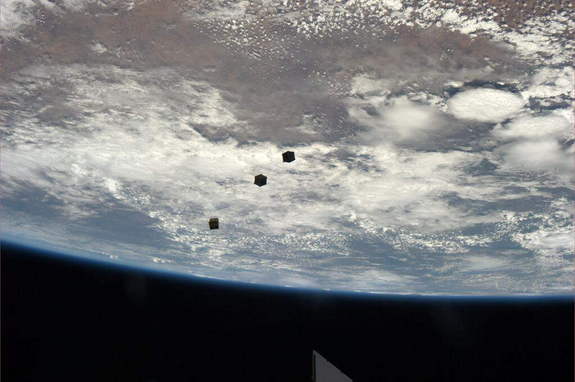Two of the 28 Dove cubesats that make up Planet Lab’s “Flock 1” constellation are seen deploying into orbit from the International Space Station on Feb. 11, 2014.
CubeSats are miniature satellites that are commonly used in low Earth orbit for applications such as remote sensing or communications. As engineers become more familiar with the technology, CubeSats are also being considered for flights outside of Earth orbit — particularly to locations such as Mars or Jupiter.
The design was first proposed in the late 1990s by two professors: Jordi Puig-Suari of California Polytechnic State University and Bob Twiggs of Stanford University. They were trying to help students gain engineering experience in satellites, which are traditionally expensive to build and launch. Inspiration for the CubeSat came in part from the miniature toy craze of the day, Beanie Babies, according to Spaceflight Now .
The basic design of a CubeSat is a 10-centimeter (4-inch) cube with a mass of less than 1.33 kilograms (2.93 pounds), the article added. But variations on the theme are possible. CubeSats can also be designed to encompass two, three or six 10-centimeter units for more complicated missions.
CubeSats reduce launch costs in two fundamental ways. They don’t weigh that much, which means a rocket doesn’t need a lot of fuel to heft them. In most cases, they also share a rocket with a larger satellite, making it possible to get to space on the coattails of the heavier payload.
There are some design challenges with CubeSats, however. The electronics are smaller and are therefore more sensitive to radiation. Because they are small, they cannot carry large payloads with them. And because most are deployed to low Earth orbit, they are only designed to last a few months or years before falling back into the atmosphere.

Three small CubeSats float above the Earth after deployment from the International Space Station. Astronaut Rick Mastracchio tweeted the photo from the station on Nov. 19, 2013.
Credit: Rick Mastracchio (via Twitter as @AstroRM)
Brief history
The first six CubeSats were launched in June 2003 from Russia’s Plesetsk launch site. At the time, according to a Space.com article from 2004 , the going rate for a CubeSat’s launch was about $40,000, which is a bargain compared to a typical satellite (that can cost hundreds of thousands, or millions.)
CubeSats were made possible by the ongoing miniaturization of electronics, which allows instruments such as cameras to ride into orbit at a fraction of the size of what was required at the beginning of the space age in the 1960s.
“Peep inside a CubeSat and you’ll spot off-the-shelf circuitry in the familiar form of microprocessors and modem ports, and other microchip devices typically used in cell phones, digital cameras and hand-held Global Positioning System (GPS) satellite navigation units,” wrote Space.com insider columnist Leonard David in 2004.
Credit: By Karl Tate, Infographics Artist
For the first decade, most CubeSats that flew came from university or research applications. Only a handful of satellites launched every year. That all began to change in 2013, when the number of launches suddenly numbered in the dozens. It was in that year that the commercial sector began to launch satellites, according to SpaceDaily .
Some prominent uses of CubeSats today include:
- The Earth observation company Planet Labs, which had nearly 90 CubeSat-sized Dove satellites in orbit as of July 2015. The CubeSats are used in everything from disaster response to climate monitoring.
- The NanoRacks CubeSat Deployer on the International Space Station, which launches CubeSats after they have been hauled to orbit aboard a visiting ISS vehicle.
- NASA’s CubeSat Launch initiative, which provides launch slots for CubeSats aboard traditional rocket launches.
Moving outside of Earth orbit
While all CubeSats to date have been in Earth orbit, a handful are expected to leave that environment very soon and venture farther afield. Here are some of the projects being planned.
Mars Cube One (MarCO) , which will launch in March 2016 along with NASA’s InSight lander. The two CubeSats will ride into space and then separate from the booster to make an independent trip to Mars. One of the spacecraft will send data back to Earth as InSight lands on Mars, while the other will be a backup.
NASA’s first Space Launch System test launch in 2018 will pioneer the rocket expected to bring humans out of low Earth orbit for the first time since the 1960s. The initial, uncrewed launch will include 13 microsatellites . These will include Lunar Flashlight, which reflects sunlight to peer into permanently shadowed craters on the moon, and NEA Scout, which will use a solar sail to fly to near-Earth asteroid 1991VG.
NASA is considering a mission to Jupiter’s icy moon Europa in the 2020s or 2030s. In 2014, NASA said it was considering including CubeSats on the mission , which would carry out functions including “reconnaissance for future landing sites, gravity fields, magnetic fields, atmospheric and plume science, and radiation measurements.” The Europa mission is still being designed and as of fall 2016, it is uncertain if CubeSats will go along for the journey.
The European Space Agency and NASA are considering a joint mission to investigate the asteroid 65803 Didymos and try to move its moon via an impactor. The mission is called Asteroid Impact & Deflection Assessment (AIDA) mission. For the European part, it’s possible that two CubeSats will ride along to do supplemental observations. If approved, the mission would launch in the 2020s.
Additional resources
Comments are closed.